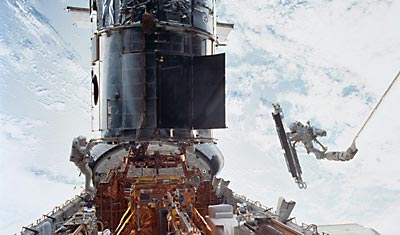Space shuttle safety and the Hubble servicing missionAbort options and Orbital Maneuvering System failureIn late January, several NASA shuttle officials held a telephone “round table” for the press to answer questions concerning plans for the shuttle return to flight. In response to a question, a shuttle official added two additional safety concerns associated with the Hubble servicing mission. These two additional points apparently did not get reported in the press, but were provided to this author by MSNBC.com correspondent Jim Oberg. First, for launches to the International Space Station, the shuttle can abort to East Coast landing sites. But when flying to the Hubble orbit, due east, there is no possibility of downrange abort until Banjul, Gambia. Second, once the shuttle is at Hubble, a failure of the Orbital Maneuvering System, such as a severe propellant tank leak, would mean that the vehicle could not successfully de-orbit. At the lower ISS orbit, the shuttle can still de-orbit using its reaction control system. NASA previously accepted this higher risk for Hubble, but is unwilling to do so now. To all of these stated reasons, one should add an additional, although unstated reason: each additional shuttle flight has a 1-in-50 chance of failure and many of the potential risks occur at launch, where no backup such as a safe haven or rescue mission would be possible. Canceling the Hubble servicing mission thus allows NASA officials not to take this added risk of losing another vehicle and crew. Anonymous criticism of the cancellation decisionBy early February, two documents by an anonymous author began circulating on Capitol Hill and in the astronomy community. These were titled “Applicability of CAIB Findings/Recommendations to HST Servicing” and “Risk Considerations for HST and ISS Flights.” These documents are more detailed than any explanation that has been publicly released by NASA concerning the cancellation decision. Grunsfeld, Readdy and the NASA Associate Administrator for Space Science, Ed Weiler, went to Capitol Hill on February 10 to explain to the House Science Committee staffers the rationale for canceling the servicing mission. According to press reports in early February, they prepared a point-by-point rebuttal to the documents, but refused to state whether this rebuttal would be publicly released. According to the New York Times, the documents were written by a NASA engineer who desired anonymity in order to protect his job. However, based upon the language they contain, Jim Oberg believes that they were not written by somebody who is intimately familiar with space shuttle operations but possibly by someone associated with the Hubble program. The CAIB called for the development of a capability to inspect and repair the space shuttle’s thermal protection system, including the reinforced carbon-carbon panels on the leading edge of the wings. The anonymously-authored documents noted that until that capability was achieved, neither ISS flights nor the HST mission would be able to achieve autonomous inspection and repair and therefore both were equally risky, although ISS would offer an added degree of safety if the shuttle could reach it. According to the anonymous author, once the capability had been achieved, there would be no significant difference between the two missions as far as this requirement was concerned. The documents also noted that the danger for a micrometeoroid and orbital debris strike is greater for a shuttle at the International Space Station than for the shuttle during a Hubble servicing mission. The reason is that during the Hubble mission, the shuttle can be oriented to minimize the potential of damage whereas at ISS its underside is exposed to the likely debris path.
The documents also addressed the requirements for a rescue capability for a crew stranded in orbit. Although a crew stranded at ISS could use the space station as a safe haven, the documents stated that this assumed no problems with the space station life support system. However, the document author argued that it would be relatively easier to mount a rescue mission for the HST servicing mission than to the ISS because the HST mission could be timed to launch shortly before a planned ISS mission and that mission could be diverted to a rescue mission if necessary. But this would still require two shuttle missions to be in processing simultaneously and NASA may be seeking to avoid that. The author also noted that if a shuttle mission to ISS did not reach the station and was stranded in orbit, it would be in the same situation as a stranded Hubble servicing mission. Reviews of servicing mission cancellation decisionIn a letter to Senator Barbara A. Mikulski on January 28 and later released by the senator, Administrator O’Keefe indicated that he had asked retired Admiral Harold Gehman, the chairman of the Columbia Accident Investigation Board, to “review the matter and offer his unique perspective.” No time frame was announced for Gehman’s review, but in mid-February Gehman’s spokesperson, Laura Brown, stated that Gehman was expected to report to Senator Mikulski around the end of February, although by March 7th no report had yet been released. Brown also stated that Gehman would primarily “explain to Senator Mikulski how and why the CAIB differentiated ISS missions from non-ISS missions when we developed the recommendations in our final report.” On March 3rd, eight members of the House of Representatives called for an independent review of NASA’s decision to cancel the servicing mission. This is, however, a non-binding request. The fate of the mission remains in the hands of Admiral Gehman and NASA. Home |
|
